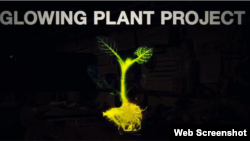Could bioluminescent plants one day replace light bulbs?
That is the goal of a group of California scientists who are looking to genetically engineer bioluminescent plants that could eventually be used as streetlights or bedside reading lamps.
“We are using Synthetic Biology techniques and Genome Compiler’s software to insert bioluminescence genes into Arabidopsis, a small flowering plant and member of the mustard family, to make a plant that visibly glows in the dark,” the scientists write on their Kickstarter page, where they are raising money for the effort.
The process is done using the so-called Agrobacterium method, meaning that specially designed DNA derived from the luminescent compounds in fireflies will be inserted into a special type of bacteria that can inject its DNA into the plant.
“Flowers of the plant are then dipped into a solution containing the transformed bacteria. The bacteria injects our DNA into the cell nucleus of the flowers which pass it onto their seeds which we can grow until they glow!” write the scientists.
The group touts glowing plants as a potentially environmentally friendly source of light that is relatively cheap, easy to dispose of and doesn’t require an external power source such as polluting batteries.
The idea of glowing plants is not new. Back in the 1980s, scientists developed a glowing plant, but it required the injection of luciferin, a compound found in many bioluminescent organisms.
The scientists say that strongly luminescent plants are still a way off.
“We hope to have a plant which you can visibly see in the dark (like glow in the dark paint) but don't expect to replace your light bulbs with version 1.0.,” they write. “The more money we raise, the more we can refine our designs and the stronger the effect we will get.”
The project is not without controversy.
According to the New York Times, two environmental organizations have asked Kickstarter and the Agriculture Department to shut down the project.
In their letter, the groups said the project “will likely result in widespread, random and uncontrolled release of bioengineered seeds and plants produced through the controversial and risky techniques of synthetic biology,” according to the New York Times.
The controversy doesn’t seem to be turning away donors. Latest figures show the project has raised more than $285,000 from over 5,000 people. The original goal was to raise $65,000.
That is the goal of a group of California scientists who are looking to genetically engineer bioluminescent plants that could eventually be used as streetlights or bedside reading lamps.
“We are using Synthetic Biology techniques and Genome Compiler’s software to insert bioluminescence genes into Arabidopsis, a small flowering plant and member of the mustard family, to make a plant that visibly glows in the dark,” the scientists write on their Kickstarter page, where they are raising money for the effort.
The process is done using the so-called Agrobacterium method, meaning that specially designed DNA derived from the luminescent compounds in fireflies will be inserted into a special type of bacteria that can inject its DNA into the plant.
“Flowers of the plant are then dipped into a solution containing the transformed bacteria. The bacteria injects our DNA into the cell nucleus of the flowers which pass it onto their seeds which we can grow until they glow!” write the scientists.
The group touts glowing plants as a potentially environmentally friendly source of light that is relatively cheap, easy to dispose of and doesn’t require an external power source such as polluting batteries.
The idea of glowing plants is not new. Back in the 1980s, scientists developed a glowing plant, but it required the injection of luciferin, a compound found in many bioluminescent organisms.
The scientists say that strongly luminescent plants are still a way off.
“We hope to have a plant which you can visibly see in the dark (like glow in the dark paint) but don't expect to replace your light bulbs with version 1.0.,” they write. “The more money we raise, the more we can refine our designs and the stronger the effect we will get.”
The project is not without controversy.
According to the New York Times, two environmental organizations have asked Kickstarter and the Agriculture Department to shut down the project.
In their letter, the groups said the project “will likely result in widespread, random and uncontrolled release of bioengineered seeds and plants produced through the controversial and risky techniques of synthetic biology,” according to the New York Times.
The controversy doesn’t seem to be turning away donors. Latest figures show the project has raised more than $285,000 from over 5,000 people. The original goal was to raise $65,000.







